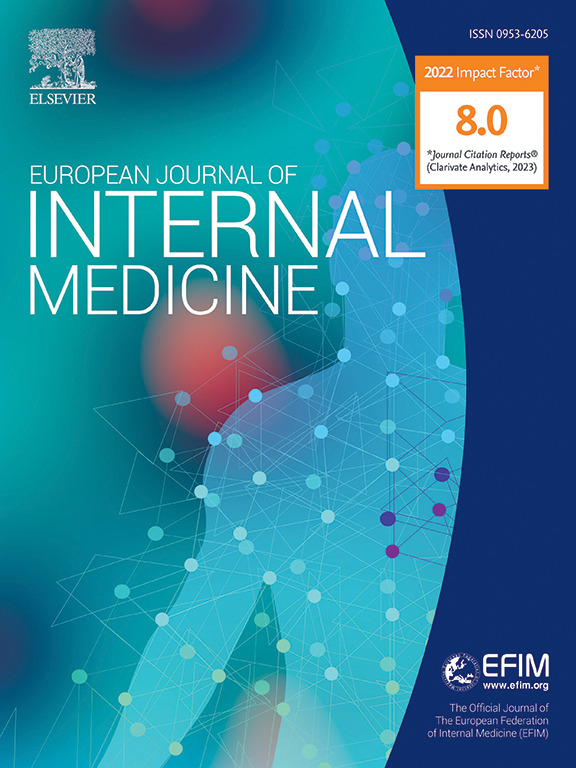将证据转化为实践:管理心力衰竭患者的电解质失衡和铁缺乏症。
IF 6.1
2区 医学
Q1 MEDICINE, GENERAL & INTERNAL
引用次数: 0
摘要
矿物质异常是心力衰竭(HF)的常见并发症。其中,40% 以上的心力衰竭患者会出现低钾血症和高钾血症,18%-27% 的患者会出现低钠血症,7%-52% 的患者会出现低镁血症,13% 的患者会出现磷酸盐失衡。这些异常是心房颤动严重程度的指标,与发病和死亡风险的增加密切相关。神经体液激活(包括肾素-血管紧张素-醛固酮系统(RAAS)、交感神经系统和血管加压素)、高血压药物(如利尿剂和 RAAS 抑制剂)以及并发疾病(如慢性肾病)都会破坏矿物质平衡。缺铁(ID)是另一种最常见的矿物质异常,影响高达 60% 的高血压患者。铁缺乏症与不良临床结果(如生活质量和运动能力下降、高血压再住院以及全因死亡率)密切相关。导致心房颤动患者出现 ID 的原因多种多样,包括厌食导致的铁摄入量减少、慢性炎症和肝充血导致的肝磷脂水平升高,以及同时使用抗血栓药物导致的隐匿性胃肠道出血。铁替代疗法的疗效已在临床试验中得到证实,尤其是在射血分数降低型心力衰竭(HFrEF)患者中,而最近的研究也表明,铁替代疗法可提高射血分数保留型心力衰竭(HFpEF)患者的运动能力。本综述重点讨论高血压患者的钾和磷酸盐异常、低钠血症、低镁血症和 ID,全面概述其机制、临床意义以及最新研究成果的干预策略。本文章由计算机程序翻译,如有差异,请以英文原文为准。
Translating evidence into practice: Managing electrolyte imbalances and iron deficiency in heart failure
Mineral abnormalities are a common complication of heart failure (HF). In particular, dyskalaemia, hyponatraemia, and hypomagnesaemia are prevalent, with hypo- and hyperkalaemia observed in over 40 % of HF patients, hyponatraemia in 18–27 %, hypomagnesaemia in 7–52 %, and phosphate imbalance in 13 %. These abnormalities serve as indicators of the severity of HF and are strongly associated with an increased risk of morbidity and mortality. The neurohumoral activation, including the renin-angiotensin-aldosterone system (RAAS), the sympathetic nervous system, and vasopressin, HF medications such as diuretics and RAAS inhibitors, amd concomitant diseases such as chronic kidney disease, can disrupt mineral homeostasis.
Iron deficiency (ID) is another of the most common mineral abnormalities, affecting up to 60 % of HF patients. ID is significantly associated with adverse clinical outcomes such as reduced quality of life and exercise capacity, HF re-hospitalization, and all-cause mortality. Various pathways contribute to the development of ID in HF, including reduced iron intake due to anorexia, increased hepcidin levels associated with chronic inflammation and hepatic congestion, and occult gastrointestinal bleeding due to the concomitant use of antithrombotic agents. The efficacy of iron replacement therapy has been demonstrated in clinical trials, particularly in heart failure with reduced ejection fraction (HFrEF), whilst more recently, it has also been shown to improve exercise capacity in patients with heart failure with preserved ejection fraction (HFpEF). This review focuses on potassium and phosphate abnormalities, hyponatraemia, hypomagnesaemia, and ID in HF, providing a comprehensive overview of the mechanisms, clinical significance, and intervention strategies with the latest findings.
求助全文
通过发布文献求助,成功后即可免费获取论文全文。
去求助
来源期刊
CiteScore
9.60
自引率
6.20%
发文量
364
审稿时长
20 days
期刊介绍:
The European Journal of Internal Medicine serves as the official journal of the European Federation of Internal Medicine and is the primary scientific reference for European academic and non-academic internists. It is dedicated to advancing science and practice in internal medicine across Europe. The journal publishes original articles, editorials, reviews, internal medicine flashcards, and other relevant information in the field. Both translational medicine and clinical studies are emphasized. EJIM aspires to be a leading platform for excellent clinical studies, with a focus on enhancing the quality of healthcare in European hospitals.

 求助内容:
求助内容: 应助结果提醒方式:
应助结果提醒方式:


